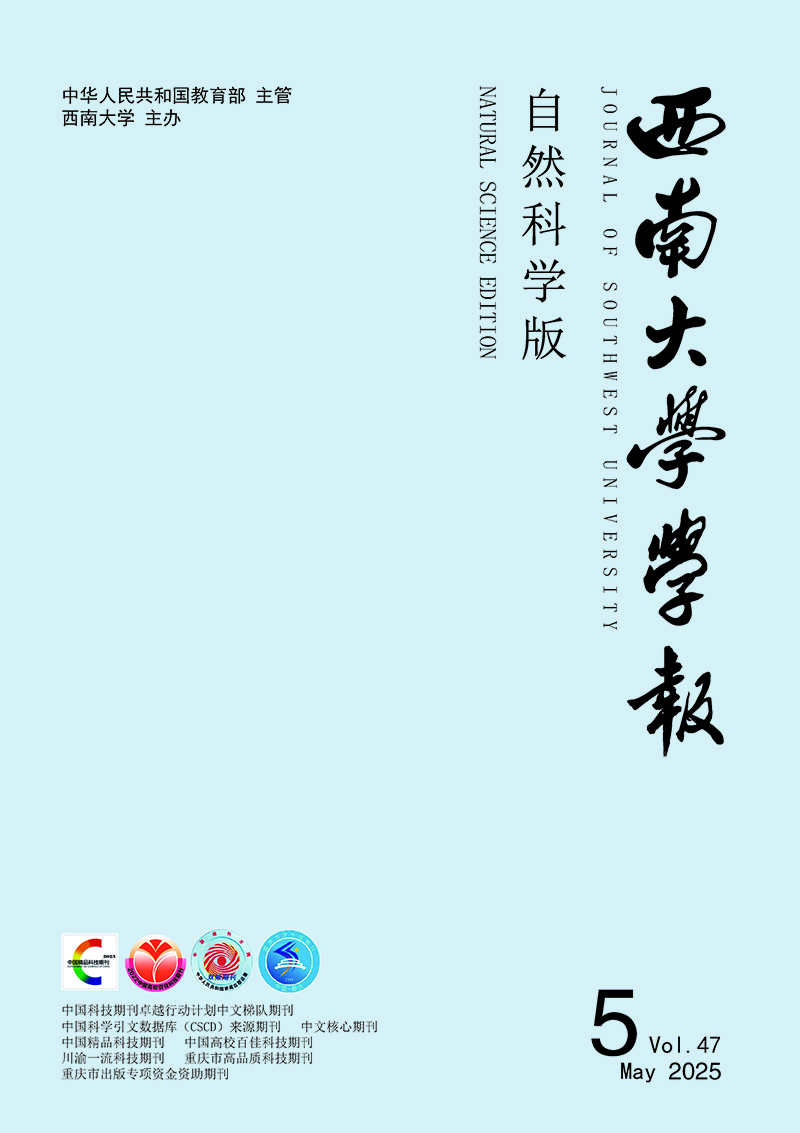-
开放科学(资源服务)标志码(OSID):

-
柑橘作为世界第一大水果,具有重要的经济价值. 自加入世贸组织以来,中国柑橘种植面积和产量增长迅速. 截至2019年,中国柑橘栽培面积为277万hm2,产量达4 584万t(2020年国家统计局数据),均位列世界首位,柑橘已成为全面实现乡村振兴的重要支柱产业. 柑橘在生产过程中受到多种因素的影响,其中由柑橘衰退病毒(Citrus tristeza virus,CTV)引起的柑橘衰退病是制约世界柑橘产业发展的一个重要因素.
CTV为长线形病毒科(Closteroviridae)长线形病毒属(Closterovirus)成员,主要通过嫁接和蚜虫进行传播. CTV基因组为一条约19 260 nt的正义单链RNA,包含两个非编码区和12个开放阅读框(ORFs),是已知最大的植物病毒[1]. CTV在田间具有复杂的株系分化现象,根据其症状差异,分为苗黄、速衰和茎陷点3种主要类型[2-4]. 同时,根据其基因组序列的变异被分为T36,VT,T30,T3,RB,T68,HA16-5和S1等多个基因型[1, 5-8]. 其中,T36与VT基因型通常与速衰症状相关,T3,VT,RB和T68基因型与茎陷点症状相关联[9-14],而S1和T30基因型通常不引起明显的症状[6, 15]. 由于CTV全序列测定的难度较大,因此ORF1a,5′UTR,RdRp等区域常被作为CTV分型的重要靶标,其中因ORF1a的多样性最为丰富,是目前使用较多的CTV分型依据[5, 16-18].
虽然CTV在中国的分布极为广泛,但由于长期以来大量使用枳、酸橙、红橘等抗耐砧木,速衰型衰退病仅在云南的宾川、建水等地有过少量发生[19]. 茎陷点型衰退病对中国柑橘产业为害较为严重,曾对四川、重庆等地的甜橙品种造成了严重损失[20]. 近年来茎陷点型衰退病在我国最重要的脐橙产区——江西赣州暴发,导致脐橙生长缓慢、树势减弱、产量和品质降低,损失严重. 前期研究显示,赣州CTV发生较为普遍,虽多为VT和T36基因型混合发生,但未曾对脐橙产业造成严重危害[21-23]. 因此,本研究拟通过研究赣州CTV种群的基因型构成及变化,以期为进一步探明江西赣州茎陷点型衰退病暴发的原因提供理论基础.
HTML
-
2019-2020年,在江西赣州大余、寻乌、章贡、南康等10个县(区)的脐橙园采集了199个疑似感染CTV的纽荷尔脐橙样品. 此外,于2004-2007年从赣州寻乌、信丰、南康纽荷尔脐橙上采集的9个CTV毒株由西南大学柑桔研究所提供.
-
从每棵植株的3个不同方向上共选取100 mg嫩叶,混合后使用RNAisoplus(TaKaRa,日本)抽提总RNA. 利用引物CP1:5′-ATGGACGACGAAACAAAG-3′,CP3:5′-TCAACGTGTGTTGAATTT-3′,进行PCR检测.
-
样品有试验获得的112份阳性样品及9份课题组前期保存的试验样品,使用前期报道的特异性引物对样品进行基因型鉴定[5, 16-18].
-
将CTV阳性样品剥皮后观察茎陷点症状,并参考Garnsey等[2]的标准对茎陷点症状的严重程度进行分级. 其中,0代表无症状,1代表轻微症状,2代表中度症状,3代表严重症状.
-
选取39个代表性的CTV阳性样品,使用墨西哥莱檬、symons甜橙、代代酸橙和琯溪蜜柚作为指示植物进行鉴定,接种1年后观察症状.
1.1. 样品采集
1.2. 方法
1.2.1. CTV检测
1.2.2. 基因型鉴定
1.2.3. 症状观察
1.2.4. 指示植物鉴定
-
采集的199份柑橘样品中,有112份感染了CTV. 所调查的区县均有CTV发生,CTV在各区县的发生率为22.2%~86.0%,平均发生率为56.3%,其中发生率最高的地区为会昌(86.0%),其次为章贡(75.0%),最低是崇义(22.2%),表明CTV在赣州脐橙果园普遍发生(表 1).
-
2019-2020年采集的112份阳性样品中能检测到T36,VT,T3,T68,T30,RB,HA16-5和S1等8个基因型,其中T36基因型检出率最高(99.1%),其次是T3(95.5%)和VT(94.6%)基因型,HA16-5基因型检出率最低(18.8%). 课题组前期保存的赣州CTV样品中,只能检测到T36,VT,T3,T68和S1等5个基因型. 所有样品中均能检测出T3和VT基因型,此外,T68,S1和T36基因型的检出率分别为33.3%,22.2%和11.1%. 相比于2004-2007年采集的样品,2019-2020年采集的样品中除了VT与T3基因型外,其余6个基因型检出率均有所上升,其中T36和RB基因型增涨最为显著(表 2).
2019-2020年采集的112份样品中均为多基因型混合发生. 以6种基因型混合发生最为常见,其次为4种基因型混合侵染,分别占总数的31.3%和26.8%. 最常见的基因型组合为T36+VT+T3+T30+S1+RB,有15个,占总数的13.4%;其次依次为T36+VT+T3+T68,T36+VT+T3+RB基因型,分别占总数的9.8%和8.0%. 2004-2007年采集的CTV样品中,也以多基因型混合发生. 其中,以VT+T3+T68和VT+T3基因型混合感染最为常见,均占其总数的33.3%,其次是VT+T3+S1基因型(22.2%),T36+VT+T3基因型混合发生的情况最少(11.1%)(表 3).
-
2004-2007年采集的9份样品茎陷点症状不明显或症状轻微. 2019-2020年采集的112份阳性样品中,有58份样品无明显的茎陷点症状或症状轻微,10份样品出现中等强度的茎陷点症状,其余44份样品均有严重的茎陷点症状. 在2019年调查时发现,茎陷点症状严重的植株较症状轻微的植株,其感染CTV的基因型构成更为复杂. 此外,植株感染HA16-5基因型后,多表现出严重的茎陷点症状,而一旦检测出T30基因型,植株的茎陷点症状多为轻微.
-
在进行指示植物鉴定的39个CTV毒株中,有34个CTV毒株在墨西哥莱檬上产生了严重的脉明和茎陷点症状,在symons甜橙上表现出严重的茎陷点症状,在代代酸橙上没有观察到明显症状,在琯溪蜜柚上出现了轻度至中等的茎陷点症状. 其余5个CTV毒株只在墨西哥来檬上产生了轻微脉明和茎陷点症状. 结果再次表明,赣州纽荷尔脐橙上流行的CTV毒株以甜橙茎陷点毒株为主.
2.1. CTV检测结果
2.2. 基因型鉴定
2.3. 症状与基因型的相关性
2.4. 指示植物鉴定
-
近年来,由于我国柑橘产业发展迅猛,优质无病毒苗木供应不足,部分地区无序繁育、调运苗木,造成多种危险性柑橘病毒病随苗木扩散,并在部分柑橘产区的发生为害日益严重[19]. 江西赣州作为世界上著名的脐橙产区之一,截至2019年,脐橙种植面积约11万hm2,产量125万t,其主要栽培品种为纽荷尔脐橙. 虽然CTV长期以来在赣州分布广泛,但均未引起严重损失,但是近年来,茎陷点型衰退病在赣州多地陆续暴发,损失严重. 因此掌握赣州CTV种群构成变化,将有助于阐明茎陷点型衰退病在赣州暴发的原因.
CTV存在复杂的株系分化现象,在不同柑橘品种上的症状差异较大. 前期研究发现茎陷点症状的产生与p33,p13,p18基因的表达比例有关[24],p23基因可诱导酸橙和葡萄柚幼苗出现苗黄症状[25-26],但决定症状强弱的关键序列区域仍不清楚. 为快速鉴定不同的CTV类型,国内外学者建立了多种分别基于血清学、单链构象多态性(SSCP)、限制性片段长度多态性法(RFLP)、基因型和全序列差异的检测方法. 其中,基因型检测因其具备快捷、且与毒株生物学性状符合度较高的特点而被广泛运用. 最初根据5′UTR,ORF1,RdRp区域的序列差异,将CTV分为了VT,T3,T30和T36等4个基因型,其中T36与VT基因型通常与速衰症状相关,T3和VT基因型与茎陷点症状相关联,而T30基因型通常不引起明显的症状[9-14]. 随后又鉴定出RB,HA16-5,S1等多个基因型[6-8].
本研究结果显示,与2004-2007年采集的赣州CTV样品,以及夏宜林[22]、刘志芳[23]的前期研究结果相比,2019和2020年采集的样品中新出现了RB,T30和HA16-5基因型,且T36和RB基因型的检出率显著上升. 由于RB基因型作为强毒株可以在耐病品种枳上引起严重的茎陷点症状,这也许是赣州茎陷点型衰退病近年来发生严重的原因. 本研究还发现,在引起轻微茎陷点症状的CTV毒株中也存在RB基因型. 由于本研究分析的靶标仅占CTV基因组约3.6%的区域,且重组是导致CTV变异的重要因素[27],因此下一步将选取代表性强弱毒株进行全序列分析,以期从分子水平上阐明赣州茎陷点型衰退病暴发的原因. 此外,本研究还发现纽荷尔脐橙感染HA16-5基因型后,多表现出严重的茎陷点症状. 前期研究暗示,HA16-5基因型不会在葡萄柚上引起严重的茎陷点症状[14]. 由于CTV具有寄主专化性的特点,因此还需要进一步明确HA16-5基因型对甜橙、柚、杂柑等中国主要柑橘栽培类型的为害特点.
-
本试验结果表明,江西赣州田间CTV的种群构成发生了改变,2019-2020年在纽荷尔脐橙园采集的CTV毒株的种群构成较2004-2007年更为复杂,强毒株相关基因型的比例显著增高,近年来赣州暴发的茎陷点型衰退病可能与RB和HA16-5基因型的出现有关.






 DownLoad:
DownLoad: